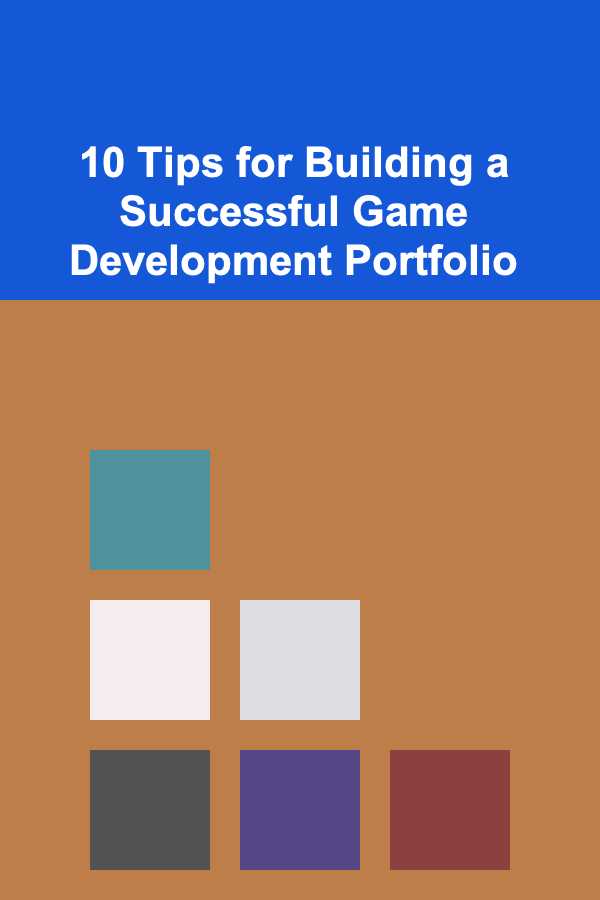
10 Tips for Building a Successful Game Development Portfolio
ebook include PDF & Audio bundle (Micro Guide)
$12.99$5.99
Limited Time Offer! Order within the next:

A game development portfolio is an essential tool for showcasing your skills, creativity, and technical expertise to potential employers or clients. Whether you're aiming to land a job at a top-tier game studio, freelance as an indie developer, or pursue a personal game development project, a well-curated portfolio can significantly increase your chances of success. Building a portfolio that stands out requires more than just listing your projects --- it requires careful thought about presentation, variety, and demonstrating real-world expertise.
In this article, we'll cover 10 crucial tips to help you build a game development portfolio that not only highlights your technical abilities but also demonstrates your creativity and passion for game development.
Choose the Right Platform for Your Portfolio
When building a game development portfolio, the platform you use to display your work can greatly impact how potential employers or clients perceive your projects. Here are a few common options for game developers:
- Personal Website: A personal website offers the most flexibility in terms of design and content. You can showcase your portfolio in an organized and personalized manner, with separate sections for different projects, blogs, or tutorials. Platforms like WordPress, Wix, and Squarespace make it relatively easy to build a professional-looking site. Additionally, owning your website domain can boost your credibility.
- GitHub: For developers focusing on programming and code-related projects, GitHub is essential. It allows you to display your projects, share your codebase, and contribute to open-source projects. Additionally, many employers value the transparency and collaboration skills demonstrated through open-source contributions.
- ArtStation/Behance: For those with an emphasis on game art, visual design, and assets, platforms like ArtStation and Behance offer an ideal space to showcase 3D models, textures, concept art, and UI designs. These platforms are widely recognized by the game development industry.
- Itch.io : If you're an indie developer, Itch.io is a great platform to release small games and prototypes. It also serves as an excellent way to build a community around your work and get feedback from players.
Regardless of the platform you choose, ensure that it is easy to navigate, visually appealing, and professional. A clean, well-organized website is far more impressive than a cluttered or hard-to-navigate portfolio.
Highlight a Variety of Projects
A successful game development portfolio isn't just about showcasing one type of project. It's about demonstrating a range of skills and versatility. Here are some ideas for the types of projects you should consider including:
- Complete Games: At least one finished, playable game is essential for your portfolio. This demonstrates that you can take a project from concept to completion, which is a crucial skill in game development. It's also helpful to showcase different genres or game types to highlight your versatility.
- Game Prototypes: Prototypes can showcase your ability to rapidly prototype and iterate on ideas. These don't have to be fully polished but should demonstrate solid gameplay mechanics or core mechanics of a game.
- Collaborative Projects: If you've worked on team-based projects, it's important to highlight those as well. This shows that you can collaborate effectively with others, a vital skill in the game development industry. Make sure to clearly define your role in the project.
- Modding or Remakes: Game mods or remakes of existing games can also be a good addition to your portfolio. They show that you can work within established frameworks, understand other games deeply, and build upon existing concepts.
By including a variety of projects, you give employers a broader picture of your skills and creativity. You may specialize in one area, but a diverse portfolio helps you stand out in a competitive industry.
Showcase the Process, Not Just the End Result
A great game development portfolio doesn't just highlight finished projects; it also showcases your development process. This gives potential employers insight into how you approach problem-solving, handle challenges, and iterate on ideas. Here's how you can do this:
- Development Diaries: Document your progress through development diaries or blog posts. Share the decisions you made, the obstacles you faced, and how you overcame them. This is especially helpful if you worked solo or in a small team, as it shows you can tackle problems and take ownership of your projects.
- Wireframes and Mockups: Include early-stage wireframes, mockups, or concept art. These visuals show the progression of your work and provide insight into how you iterate through design ideas. For game artists, showing the evolution of assets (such as from 2D sketches to 3D models) is important.
- Code Snippets and Technical Breakdown: If your expertise is in programming, consider sharing code snippets, problem-solving strategies, or a technical breakdown of complex systems you've developed. This allows potential employers to see the depth of your programming knowledge and problem-solving ability.
Including your process not only highlights your technical skills but also demonstrates how you think creatively and solve problems, which is valuable for any game development role.
Focus on Quality Over Quantity
While it's important to showcase a variety of projects, quality should always come before quantity. A few high-quality, polished projects are far more impactful than dozens of half-finished games. A well-executed project speaks volumes about your skill level, attention to detail, and commitment to delivering a finished product.
Here are some tips for focusing on quality:
- Polish Your Projects: Ensure that the projects you showcase are polished and bug-free. Even if it's a small indie project, it's better to have a few games that are fully functional and visually appealing than many unfinished prototypes.
- Iterate and Improve: Don't just showcase your initial versions of projects. Update and improve older projects as your skills evolve. For example, you could revisit a past game and add new features, improve its graphics, or refactor the code to demonstrate how your skills have developed.
- Avoid Overloading Your Portfolio: Limit the number of projects you showcase to those you are most proud of. Curate your portfolio carefully, making sure that each project represents your best work.
A small number of well-polished projects will leave a lasting impression and reflect a higher level of professionalism.
Clearly Define Your Role in Collaborative Projects
In collaborative projects, it's important to make your specific contributions clear. Employers want to know what you did on a team project, whether it was programming, game design, art, or another area. This is particularly important when showcasing collaborative work, as it can be difficult to discern individual contributions.
Here's how to clarify your role:
- Highlight Specific Contributions: On each collaborative project, explain your specific responsibilities. Did you handle the game mechanics, write the code, create the art, or implement the audio? Being clear about your contributions will help employers understand your specific skills.
- Teamwork Skills: If possible, describe how you collaborated with others. Did you work closely with artists, designers, or sound engineers? Highlighting how you contribute to a team shows your ability to communicate and collaborate effectively, which is essential in game development.
By clearly outlining your role in collaborative projects, you showcase your ability to work well in teams and your specific strengths within a development environment.
Demonstrate a Strong Understanding of Game Design Principles
In addition to your technical skills, a great game developer must understand the fundamentals of game design. Your portfolio should demonstrate that you understand the core principles of gameplay, narrative design, level design, and player experience.
Here are a few ways to demonstrate your understanding of game design:
- Gameplay Mechanics: Include examples of well-designed mechanics, such as balanced difficulty curves, intuitive controls, and engaging core loops. Explain the reasoning behind your design decisions and how they contribute to the player's experience.
- Level and World Design: Show examples of how you design levels or worlds, focusing on how you create environments that support gameplay and encourage exploration or challenge. You can show level maps, environmental art, or even documentation explaining the level flow.
- Player-Centered Design: Explain how you design with the player in mind. This could be through player testing, iteration, and adjusting game elements to make the experience more enjoyable. Include feedback you've received from players and how you've implemented changes based on that input.
By showcasing your understanding of game design principles, you make it clear that you're not just a programmer or artist --- you're a well-rounded game developer who understands how to create fun, engaging, and meaningful experiences for players.
Keep Your Portfolio Up to Date
An outdated portfolio can be a red flag for potential employers. Game development is a rapidly evolving field, and you need to keep your portfolio updated with your latest projects, skills, and achievements. Here's how to maintain an up-to-date portfolio:
- Add New Projects Regularly: Continuously add new projects to your portfolio as you complete them. This shows that you are actively working and growing as a developer.
- Refine Old Projects: As you learn new skills, go back and refine old projects. Update code, enhance art assets, or improve gameplay mechanics to reflect your current abilities.
- Remove Obsolete Content: If some projects no longer represent your current skill level or interests, consider removing them from your portfolio. Only keep projects that showcase your best work.
An up-to-date portfolio demonstrates that you are actively engaged in game development and always improving your craft.
Show Your Passion and Personality
A game development portfolio isn't just about showcasing your skills; it's also about showing who you are as a developer. Your portfolio is an opportunity to inject some personality and passion into your work.
Here are a few ways to show your passion:
- Project Descriptions: Include personal insights and stories about the projects you've worked on. Why did you choose to work on a particular game? What challenges did you face, and how did you overcome them? Your personal story adds authenticity to your portfolio.
- Passion Projects: If you have side projects or games that you're passionate about, make sure to include them. These might not be fully finished or perfect, but they show that you care deeply about game development and are motivated by more than just landing a job.
- Blog or Video Updates: Consider adding a blog or vlog to your portfolio where you share your thoughts on game development, trends in the industry, or your creative process. This can help potential employers get to know you beyond your technical skills.
Let your portfolio reflect who you are as a developer, and it will make your work stand out even more.
Seek Feedback and Iterate
A great game development portfolio is constantly evolving. To ensure that your portfolio resonates with potential employers, it's crucial to seek feedback and iterate on it. Share your portfolio with fellow developers, mentors, or friends, and ask for constructive criticism.
Consider the following:
- Get Feedback from Industry Professionals: Ask for feedback from industry professionals or mentors who can provide valuable insights into what works and what doesn't.
- Test Your Portfolio: Put yourself in the shoes of a potential employer. Is your portfolio easy to navigate? Does it showcase your skills clearly? Use your portfolio in real-world scenarios to identify areas for improvement.
- Stay Open to Change: Don't be afraid to update your portfolio regularly based on feedback. It's a living document that should grow with you as a developer.
Iterating on your portfolio will ensure that it remains relevant and effective in showcasing your skills.
Keep Learning and Expanding Your Skills
The game development field is constantly evolving, and it's essential to keep learning and expanding your skills. Whether you're improving your programming knowledge, learning new game engines, or mastering new art techniques, continual learning ensures that your portfolio reflects the latest trends and technologies in game development.
- Learn New Tools and Technologies: Stay up-to-date with the latest game development tools, engines (like Unity or Unreal Engine), and programming languages. Show that you're adaptable and willing to learn new technologies.
- Participate in Game Jams: Game jams are a great way to improve your skills, work under pressure, and meet other developers. Participating in game jams allows you to add new projects to your portfolio and gain experience in fast-paced development environments.
- Focus on Personal Growth: The more you learn and grow as a game developer, the more impressive your portfolio will become. Keep pushing yourself to learn and innovate.
Continual learning will ensure your portfolio stays fresh, dynamic, and full of cutting-edge work.
By following these 10 tips, you can build a game development portfolio that not only showcases your technical expertise but also your passion, creativity, and problem-solving abilities. Remember, your portfolio is a reflection of who you are as a developer, so make sure it highlights your strengths, experiences, and aspirations. A well-crafted portfolio can be the key to unlocking new opportunities in the exciting world of game development.
Reading More From Our Other Websites
- [Personal Investment 101] How to Use Peer Reviews and Research to Make Smarter Investments
- [Personal Investment 101] How to Invest in Peer-to-Peer Lending Platforms in the UK
- [Metal Stamping Tip 101] Choosing the Right Metal Stamping Equipment: A Guide for Small to Mid‑Size Manufacturers
- [Horseback Riding Tip 101] Is It Worth It? Evaluating the Value of Different Horse Riding Lesson Packages
- [Home Rental Property 101] How to Rent Your Property During the Off-Season
- [Mindful Eating Tip 101] Fuel with Focus: How Mindful Eating Elevates Athletic Performance
- [Home Lighting 101] How to Integrate Motion-Sensor Lights into Your Smart Home System
- [Soap Making Tip 101] How to Blend Fragrance Oils: A Beginner's Guide to Perfect Soap Aromas
- [Home Party Planning 101] How to Create a Fun DIY Craft Station for Your Party
- [Organization Tip 101] How to Organize Small Electronics and Cords

Cost-Effective Gym Memberships: How to Stay Fit Without Breaking the Bank
Read More
How to Clean Your Oven with Natural Ingredients
Read More
How to Create a DIY Essential Oil Shelf for Your Home
Read More
How to Embrace Imperfection
Read More
How to Make a Checklist for Engaging Influencers for Product Launch Promotion
Read More
10 Tips for a Tax Checklist for Cryptocurrency Investors
Read MoreOther Products

Cost-Effective Gym Memberships: How to Stay Fit Without Breaking the Bank
Read More
How to Clean Your Oven with Natural Ingredients
Read More
How to Create a DIY Essential Oil Shelf for Your Home
Read More
How to Embrace Imperfection
Read More
How to Make a Checklist for Engaging Influencers for Product Launch Promotion
Read More